The Time Delays in Reaction of the Ionosphere and the Earth’s Magnetic Field to the Solar Flares on 8 May and Geomagnetic Superstorm on 10 May 2024
Abstract
1. Introduction
- -
- The fast impulsive disturbances and time delays in the reaction of the ionosphere and the Earth’s magnetic field to the solar flares on 8 May 2024, which preceded a geomagnetic storm;
- -
- Peculiarities of the ionospheric response in the Doppler frequency shift (DFS) and establishment of its time delay relative to the sudden commencement of the extreme G5-level geomagnetic storm on 10 May 2024.
2. Method
2.1. Data Sources
2.2. The Doppler Sounding Equipment
2.3. Calculation of the Trajectory and Reflection Height of Sounding Radio Wave
3. Results
3.1. The Effect of Solar Flares on the Ionosphere
3.2. The Response of the Ionosphere in the DFS to the X1.0 Solar Flare
3.3. The Time Delay Between the Reaction of the Ionosphere and Geomagnetic Field to a X1.0 Solar Flare
3.4. The Geomagnetic Superstorm on 10 May 2024
3.5. Reaction of the Ionosphere to the Sudden Commencement of the Geomagnetic Storm on 10 May 2024
4. Discussion and Conclusions
- 1.
- Ionization of the ionosphere by the extreme X-ray and EUV radiation of solar flares was accompanied by the sudden and similar in duration disturbances of Doppler frequency with an amplitude of 2–5.8 Hz. The greatest pulsed burst of the DFS was registered, with a 68 s long delay, during an X1.0 flare, when the changing rate of the X-ray flux was the highest, and the calculated reflection altitude of the sounding radio wave was 150.9 km. The duration of the disturbance in Doppler frequencies was about 660 s, and they generally corresponded to the length of the burst of ionizing radiation in the X-ray and EUV ranges of the electromagnetic spectrum.
- 2.
- The disturbance in the geomagnetic field, as registered by the induction magnetometer, followed the ionospheric response to the solar flare with a 35 s delay. Seemingly, the reaction of the geomagnetic field is connected with an increase in the conductivity of the ionized medium in the ionosphere at the time of solar flare, and it originates from the contribution of ionospheric currents and electric fields that modify the Earth’s magnetic field. Thus, our data showed that the response of the geomagnetic field is secondary in relation to the ionospheric disturbance caused by the solar flare.
- 3.
- On 10 May 2024, at 17:06:02 UT, the ground-based magnetometers IMS-008 and LEMI-008 registered the bursts in the variation of the magnetic field, which corresponded to a sudden storm commencement. The impulsive response of the ionosphere at the 267.5 km reflection height of the sounding radio wave was detected 58 s after the SSC moment.
- 4.
- The Doppler frequency did vary suddenly, and its change had a bipolar character, reflecting complex dynamic transformations in the ionosphere at the SSC. During 86 s, the amplitude of the DFS was firstly rising up to Hz; then, its sharp decrease was followed by a decline down to Hz.
- 5.
- Practically simultaneously with an increase in the and indices, which characterize the disturbance level of the geomagnetic field, the Doppler ionosonde detected an appearance of the medium-scale TIDs in a 30–120 min interval of time periods. The maximum TIDs level was achieved at night on 10 May, 142 min after the SSC.
Author Contributions
Funding
Institutional Review Board Statement
Informed Consent Statement
Data Availability Statement
Conflicts of Interest
References
- Kwak, Y.S.; Kim, J.H.; Kim, S.; Miyashita, Y.; Yang, T.; Park, S.H.; Lim, E.K.; Jung, J.; Kam, H.; Lee, J.; et al. Observational overview of the May 2024 G5-level geomagnetic storm: From solar eruptions to terrestrial consequences. J. Astron. Space Sci. 2024, 41, 171–194. [Google Scholar] [CrossRef]
- Spogli, L.; Alberti, T.; Bagiacchi, P.; Cafarella, L.; Cesaroni, C.; Cianchini, G.; Coco, I.; Di Mauro, D.; Ghidoni, R.; Giannattasio, F.; et al. The effects of the May 2024 Mother’s Day superstorm over the Mediterranean sector: From data to public communication. Ann. Geophys. 2024, 67, PA218. [Google Scholar] [CrossRef]
- Guo, X.; Zhao, B.; Yu, T.; Hao, H.; Sun, W.; Wang, G.; He, M.; Mao, T.; Li, G.; Ren, Z. East–West difference in the ionospheric response during the recovery phase of May 2024 super geomagnetic storm over the East Asian. J. Geophys. Res. Space Phys. 2024, 129, e2024JA033170. [Google Scholar] [CrossRef]
- Pierrard, V.; Winant, A.; Botek, E.; Péters de Bonhome, M. The Mother’s Day solar storm of 11 May 2024 and its effect on Earth’s radiation belts. Universe 2024, 10, 391. [Google Scholar] [CrossRef]
- Piersanti, M.; Oliveira, D.M.; D’Angelo, G.; Diego, P.; Napoletano, G.; Zesta, E. On the geoelectric field response to the SSC of the May 2024 super storm over Europe. Space Weather 2025, 23, e2024SW004191. [Google Scholar] [CrossRef]
- Bojilova, R.; Mukhtarov, P.; Pancheva, D. Global ionospheric response during extreme geomagnetic storm in May 2024. Remote Sens. 2024, 16, 4046. [Google Scholar] [CrossRef]
- Paul, K.S.; Haralambous, H.; Moses, M.; Oikonomou, C.; Potirakis, S.M.; Bergeot, N.; Chevalier, J.M. Investigation of the ionospheric response on Mother’s Day 2024 geomagnetic superstorm over the European sector. Atmosphere 2025, 16, 180. [Google Scholar] [CrossRef]
- Pierrard, V.; Verhulst, T.G.W.; Chevalier, J.M.; Bergeot, N.; Winant, A. Effects of the geomagnetic superstorms of 10–11 May 2024 and 7–11 October 2024 on the ionosphere and plasmasphere. Atmosphere 2025, 16, 299. [Google Scholar] [CrossRef]
- Nogueira, P.A.B.; Abdu, M.A.; Souza, J.R.; Denardini, C.M.; Barbosa Neto, P.F.; Serra de Souza da Costa, J.P.; Silva, A.P.M. Latitude-dependent delay in the responses of the equatorial electrojet and Sq currents to X-class solar flares. Ann. Geophys. 2018, 36, 139–147. [Google Scholar] [CrossRef]
- Barta, V.; Natras, R.; Srećković, V.; Koronczay, D.; Schmidt, M.; šulic, D. Multi-instrumental investigation of the solar flares impact on the ionosphere on 05–06 December 2006. Front. Environ. Sci. 2022, 10, 904335. [Google Scholar] [CrossRef]
- Liu, X.; Liu, J.; Chen, J.; Qian, L.; Chamberlin, P.C.; Chen, Y.; Kong, X.; Li, S. Impacts of extreme ultraviolet late phase of the solar flare on ionospheric electrodynamics. Astrophys. J. Lett. 2024, 974, L19. [Google Scholar] [CrossRef]
- Laboratory of X-Ray Astronomy of the Sun. Magnetic Storms. Available online: https://xras.ru/magnetic_storms.html (accessed on 1 March 2025).
- Altaibek, A.; Zhumabayev, B.; Sarsembayeva, A.; Nurtas, M.; Zakir, D. Enhancing geomagnetic disturbance predictions with neural networks: A case study on K-index classification. Atmosphere 2025, 16, 267. [Google Scholar] [CrossRef]
- Tulasi Ram, S.; Veenadhari, B.; Dimri, A.P.; Bulusu, J.; Bagiya, M.; Gurubaran, S.; Parihar, N.; Remya, B.; Seemala, G.; Singh, R.; et al. Super-intense geomagnetic storm on 10–11 May 2024: Possible mechanisms and impacts. Space Weather 2024, 22, e2024SW004126. [Google Scholar] [CrossRef] [PubMed]
- Evans, J.S.; Correira, J.; Lumpe, J.D.; Eastes, R.W.; Gan, Q.; Laskar, F.I.; Aryal, S.; Wang, W.; Burns, A.G.; Beland, S.; et al. GOLD observations of the thermospheric response to the 10–12 May 2024 Gannon superstorm. Geophys. Res. Lett. 2024, 51, e2024GL110506. [Google Scholar] [CrossRef]
- Liu, X.; Xu, J.; Yue, J.; Wang, W.; Moro, J. Mesosphere and lower thermosphere temperature responses to the May 2024 Mother’s Day storm. Geophys. Res. Lett. 2025, 52, e2024GL112179. [Google Scholar] [CrossRef]
- Afraimovich, E.L.; Lesyuta, O.S. Simultaneous response of the mid-latitude ionosphere to a sudden commencement of strong magnetic storms. Cosm. Res. 2003, 41, 110–118. [Google Scholar] [CrossRef]
- Obridko, V.N.; Kanonidi, C.D.; Mitrofanova, T.A.; Shelting, D.B. Solar activity and geomagnetic disturbances. Geomagn. Aeron. 2013, 53, 157–166. (In Russian) [Google Scholar] [CrossRef]
- Appleton, E.V. A note on the “sluggishness” of the ionosphere. J. Atm. Terr. Phys. 1953, 3, 282–284. [Google Scholar] [CrossRef]
- Davies, K. Ionospheric Radio; The Institution of Engineering and Technology: Stevenage, UK, 1990; p. 600. [Google Scholar] [CrossRef]
- Palit, S.; Basak, T.; Pal, S.; Chakrabarti, S.K. Theoretical study of lower ionospheric response to solar flares: Sluggishness of D-region and peak time delay. Astrophys. Space Sci. 2015, 356, 19–28. [Google Scholar] [CrossRef]
- Chakraborty, S.; Ruohoniemi, J.M.; Baker, J.B.H.; Fiori, R.A.D.; Bailey, S.M.; Zawdie, K.A. Ionospheric sluggishness: A characteristic time-Lag of the ionospheric response to solar flares. J. Geophys. Res. Space Phys. 2021, 126, e2020JA028813. [Google Scholar] [CrossRef]
- Briand, C.; Clilverd, M.; Inturi, S.; Cecconi, B. Role of hard X-ray emission in ionospheric D-layer disturbances during solar flares. Earth Planets Space 2022, 74, 41–74. [Google Scholar] [CrossRef]
- The Solar and Heliospheric Observatory (SOHO) Project. Available online: https://sohoftp.nascom.nasa.gov/sdb/goes/ace/daily/ (accessed on 1 March 2025).
- Extreme ultraviolet Variability Experiment (EVE). Available online: https://lasp.colorado.edu/eve/data_access/eve-one-minute-averages/index.html (accessed on 1 March 2025).
- Laboratory of X-Ray Astronomy of the Sun. Solar Flares. Available online: https://xras.ru/en/sun_flares.html (accessed on 1 March 2025).[Green Version]
- Geomagnetic Measurements. Available online: https://ionos.kz/geomagnetic-observatory (accessed on 1 March 2025).[Green Version]
- International Real-time Magnetic Observatory Network (INTERMAGNET). Available online: https://intermagnet.org (accessed on 1 March 2025).[Green Version]
- Salikhov, N.; Shepetov, A.; Pak, G.; Saveliev, V.; Nurakynov, S.; Ryabov, V.; Zhukov, V. A PLL-Based Doppler Method Using an SDR-Receiver for Investigation of Seismogenic and Man-Made Disturbances in the Ionosphere. Geosciences 2024, 14, 192. [Google Scholar] [CrossRef]
- SDRplay.com. Available online: https://www.sdrplay.com/ (accessed on 1 March 2025).
- BBC Frequencies and Sites. Available online: https://www.short-wave.info (accessed on 1 March 2025).
- CCMC Instant Run System. Community Coordinated Modeling Center. Available online: https://kauai.ccmc.gsfc.nasa.gov/instantrun/iri/ (accessed on 4 May 2025).
- Community Coordinated Modeling Center. DGRF/IGRF Geomagnetic Field Model 1945–2030. Available online: https://ccmc.gsfc.nasa.gov/modelweb/models/igrf_vitmo.php (accessed on 1 March 2025).
- Krasnov, V.M.; Kuleshov, Y.V. Influence of oscillating polarization current on the propagation of shot radio waves. J. Radio Electron. 2024, 6, 19–28. (In Russian) [Google Scholar] [CrossRef]
- Rishbeth, H.; Garriot, O.K. Introduction to Ionospheric Physics; Academic Press: New York, NY, USA; London, UK, 1969; Volume 14, pp. 87–120. [Google Scholar]
- Zolesi, B.; Cander, L.R. Ionospheric Prediction and Forecasting; Springer Geophysics; Springer: Berlin/Heidelberg, Germany, 2000. [Google Scholar] [CrossRef]
- Buzás, A.; Kouba, D.; Mielich, J.; Burešová, D.; Mošna, Z.; Knížová, P.K.; Barta, V. Investigating the effect of large solar flares on the ionosphere based on novel Digisonde data comparing three different methods. Front. Astron. Space Sci. 2023, 10, 1201625. [Google Scholar] [CrossRef]
- Richards, P.G. Seasonal and solar cycle variations of the ionospheric peak electron density: Comparison of measurement and models. J. Geophys. Res. Space Phys. 2001, 106, 12803–12819. [Google Scholar] [CrossRef]
- Vaishnav, R.; Schmölter, E.; Jacobi, C.; Berdermann, J.; Codrescu, M. Ionospheric response to solar extreme ultraviolet radiation variations: Comparison based on CTIPe model simulations and satellite measurements. Ann. Geophys. 2021, 39, 341–355. [Google Scholar] [CrossRef]
- Salikhov, N.M.; Pak, G.D. Ionospheric effects of solar flares and earthquake according to Doppler frequency shift on an inclined radio path. Bull. Nat. Acad. Sci. Kazakhstan Repub. 2020, 331, 108–115. [Google Scholar] [CrossRef]
- Appleton, E.V.; Barnett, M.A.F. On some direct evidence for downward atmospheric reflection of electric rays. Proc. R. Soc. Lond. 1925, 109, 621–641. [Google Scholar] [CrossRef]
- Mendillo, M.; Lin, D.; Schuck, S. The impact of solar X-ray flares on the ionosphere: A Review. Space Weather 2018, 16, 1435–1463. [Google Scholar]
- Matsushita, S. Solar quiet and lunar daily variations in a uniform external field. J. Geophys. Res. 1967, 72, 1639–1649. [Google Scholar]
- Helmholtz Centre for Geosciences. Geomagnetic Kp Index. Available online: https://kp.gfz.de/en/figures/kp-since-1932 (accessed on 1 March 2025).
- Hines, C.O. Internal atmospheric gravity waves at ionospheric heights. In The Upper Atmosphere in Motion; American Geophysical Union (AGU): Washington, DC, USA, 1974; pp. 248–328. [Google Scholar] [CrossRef]
- Francis, S.H. Global propagation of atmospheric gravity waves: A review. J. Atm. Terr. Phys. 1975, 37, 1011–1054. [Google Scholar] [CrossRef]
- Parhomov, V.A.; Borodkova, N.L.; Yahnin, A.G.; Tero, R.; Tsegmed, B.; Khomutov, S.Y.; Pashinin, A.Y.; Chilikin, V.E.; Mochalov, A.A. Magnetospheric response of two types in PSc geomagnetic pulsations to interaction with interplanetary shock waves. Solar-Terr. Phys. 2018, 4, 68–83. [Google Scholar] [CrossRef]



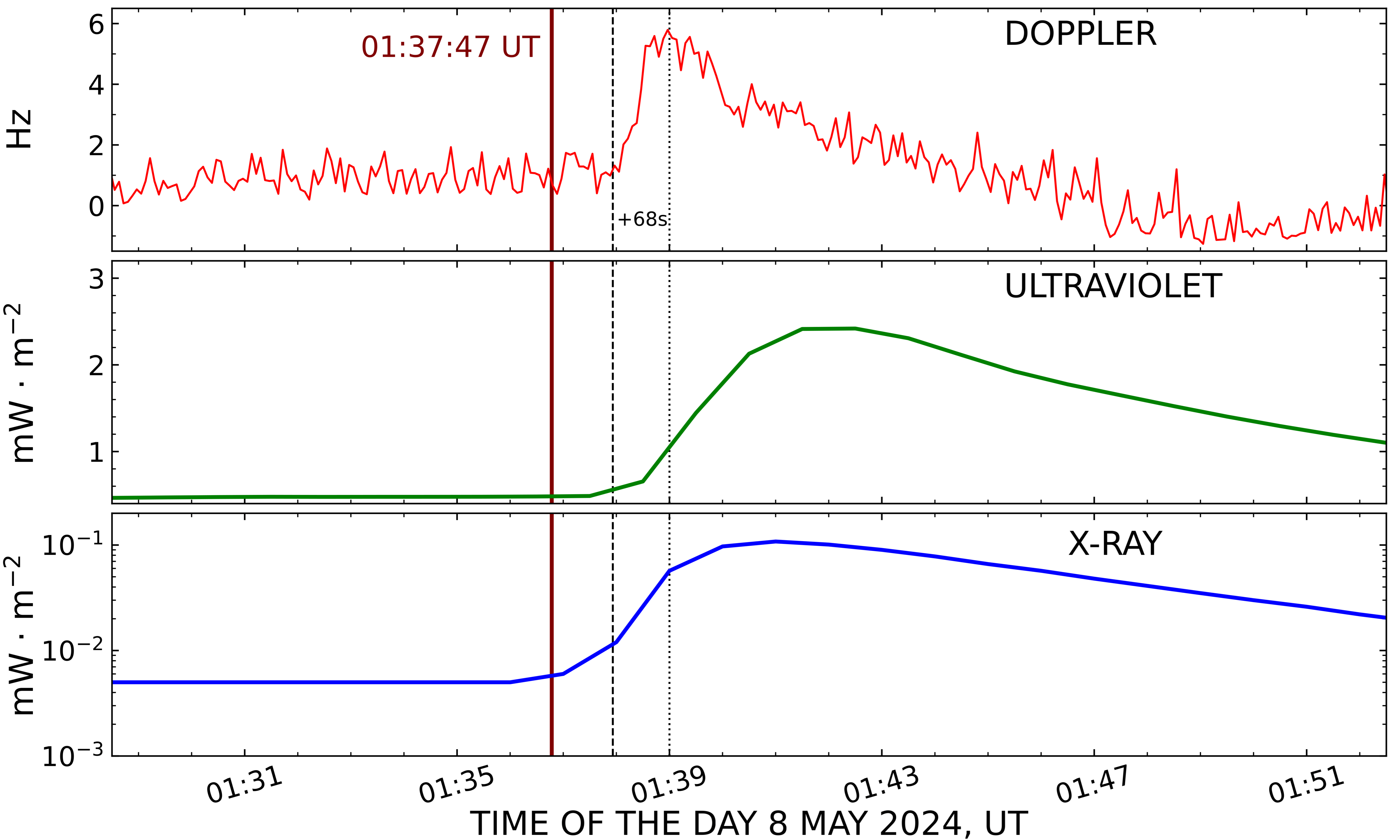


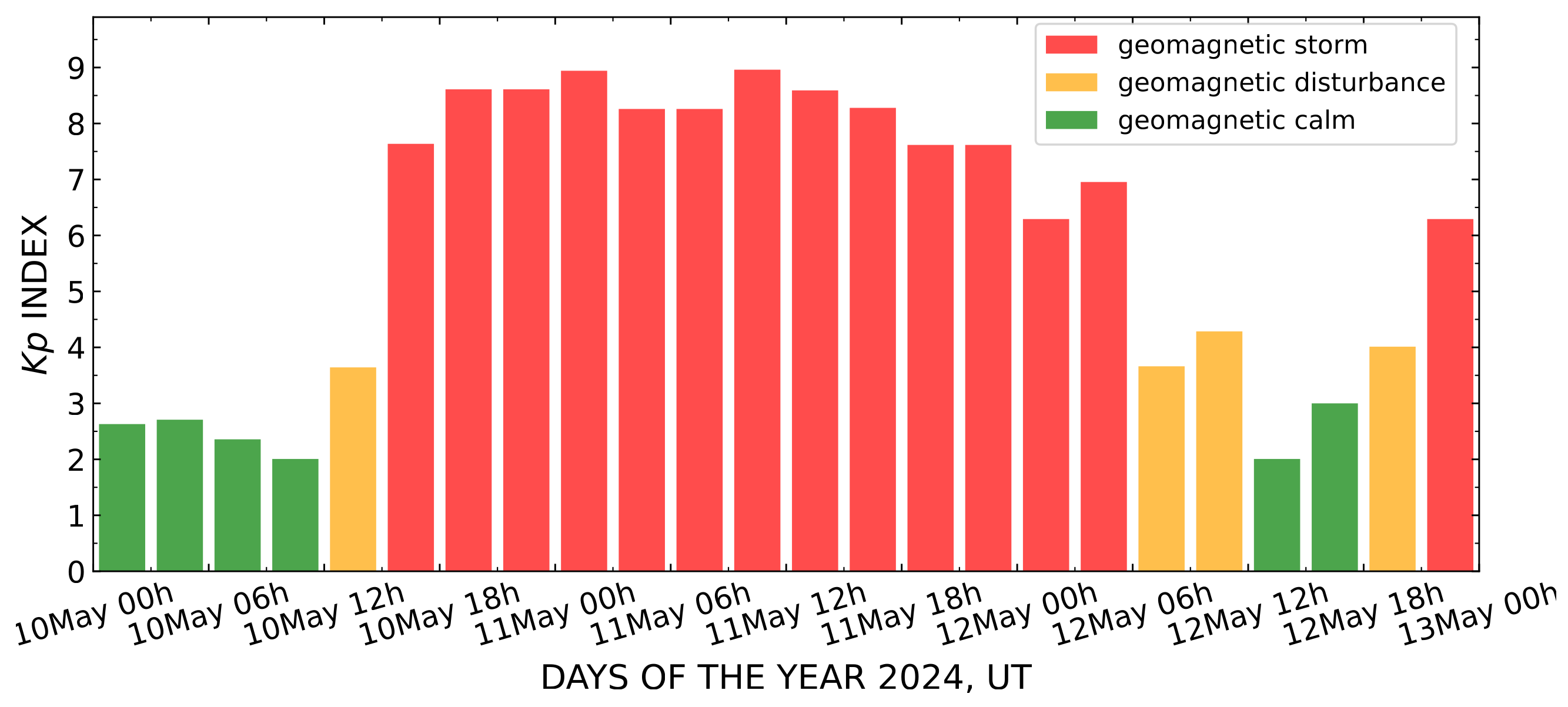
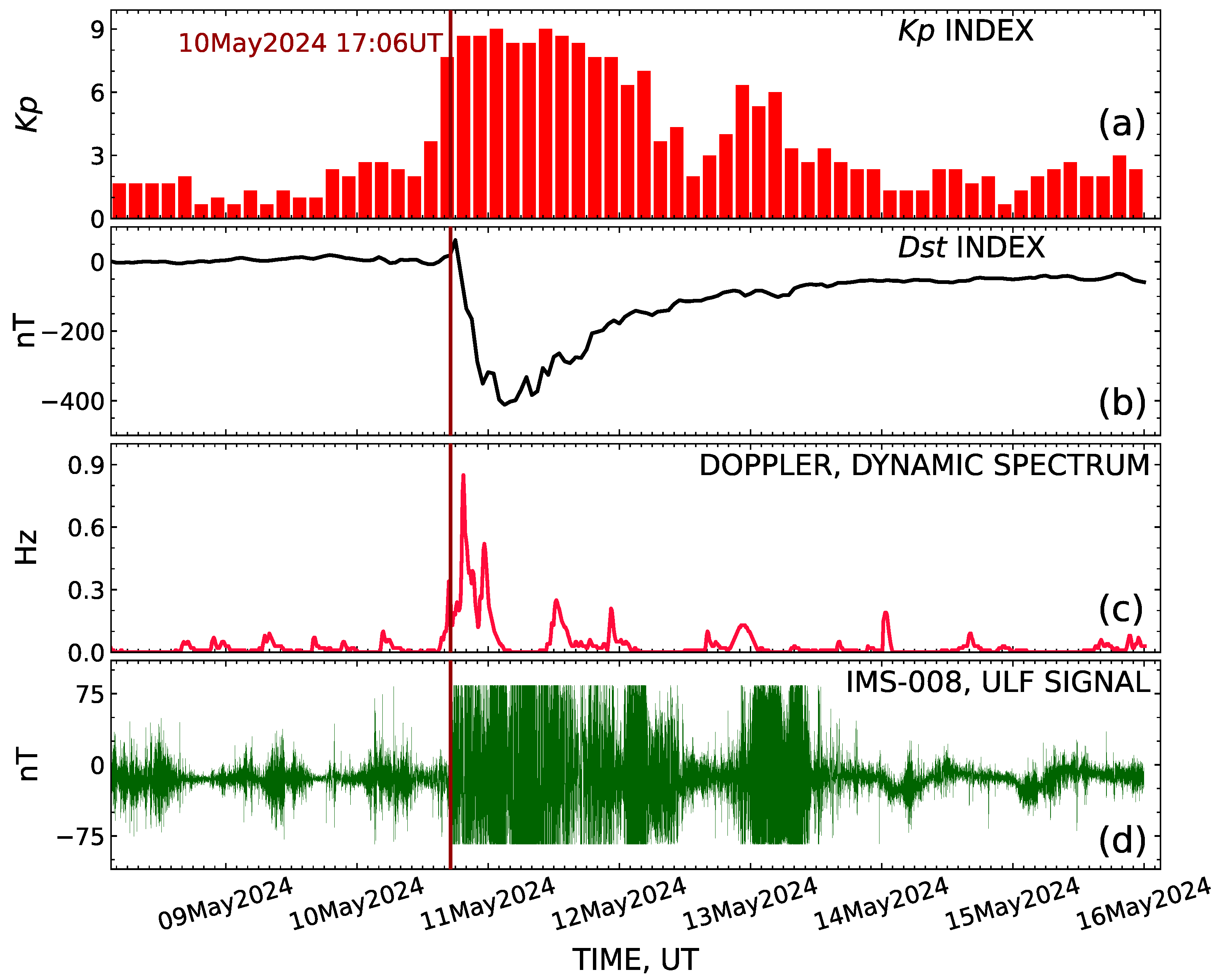
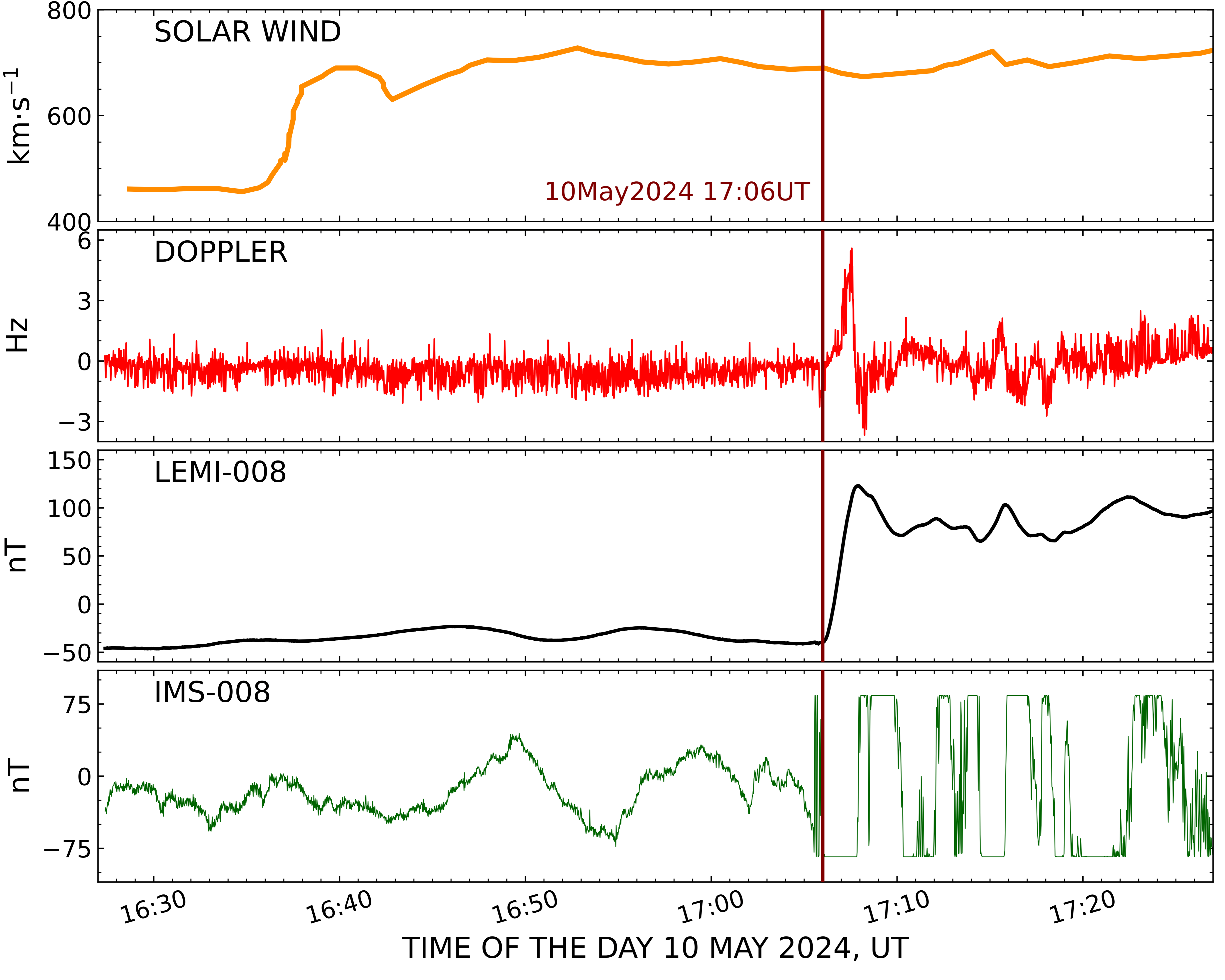
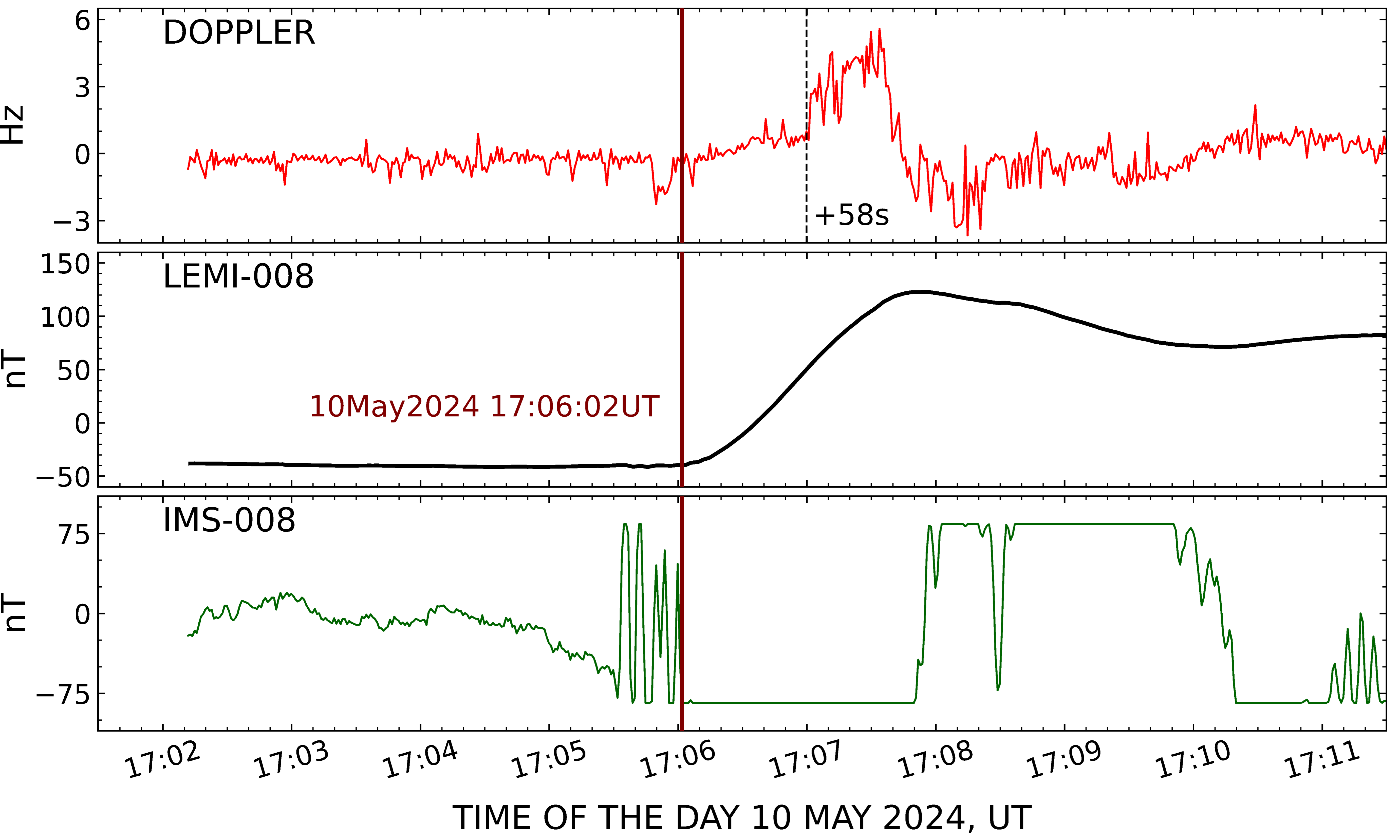
| # | Geomagnetic Observatory | Geographical Coordinates | Time Zone | Local Solar Time | Presence of Effect |
|---|---|---|---|---|---|
| 1 | AAA (Almaty, Kazakhstan) | 43.250° N 76.920° E | UT+5 | 6:46 | + |
| 2 | ARS (Arti, Russia) | 56.433° N 58.567° E | UT+5 | 5:34 | + |
| 3 | NVS (Novosibirsk, Russia) | 54.850° N 83.230° E | UT+7 | 7:11 | + |
| 4 | IRT (Irkutsk, Russia) | 52.170° N 104.450° E | UT+8 | 8:36 | + |
| 5 | MMB (Memanbetsu, Japan) | 43.910° N 144.190° E | UT+9 | 11:15 | − |
| 6 | PET (Paratunka, Russia) | 52.971° N 158.248° E | UT+12 | 12:11 | − |
| 7 | HLP (Hel, Poland) | 54.604° N 18.811° E | UT+2 | 2:49 | − |
| 8 | LVV (Lviv, Ukraine) | 49.900° N 23.750° E | UT+3 | 3:13 | − |
| Date | Year | , nT | Class |
|---|---|---|---|
| 10–13 May 2024 | 2024 | Great | |
| 9–13 March 1989 | 1989 | Great | |
| 15–16 July 1959 | 1959 | Great | |
| 11 February 1958 | 1958 | Great | |
| 13–14 September 1957 | 1957 | Great |
Disclaimer/Publisher’s Note: The statements, opinions and data contained in all publications are solely those of the individual author(s) and contributor(s) and not of MDPI and/or the editor(s). MDPI and/or the editor(s) disclaim responsibility for any injury to people or property resulting from any ideas, methods, instructions or products referred to in the content. |
© 2025 by the authors. Licensee MDPI, Basel, Switzerland. This article is an open access article distributed under the terms and conditions of the Creative Commons Attribution (CC BY) license (https://creativecommons.org/licenses/by/4.0/).
Share and Cite
Salikhov, N.; Shepetov, A.; Pak, G.; Nurakynov, S.; Ryabov, V.; Zhantayev, Z.; Zhukov, V. The Time Delays in Reaction of the Ionosphere and the Earth’s Magnetic Field to the Solar Flares on 8 May and Geomagnetic Superstorm on 10 May 2024. Atmosphere 2025, 16, 1106. https://doi.org/10.3390/atmos16091106
Salikhov N, Shepetov A, Pak G, Nurakynov S, Ryabov V, Zhantayev Z, Zhukov V. The Time Delays in Reaction of the Ionosphere and the Earth’s Magnetic Field to the Solar Flares on 8 May and Geomagnetic Superstorm on 10 May 2024. Atmosphere. 2025; 16(9):1106. https://doi.org/10.3390/atmos16091106
Chicago/Turabian StyleSalikhov, Nazyf, Alexander Shepetov, Galina Pak, Serik Nurakynov, Vladimir Ryabov, Zhumabek Zhantayev, and Valery Zhukov. 2025. "The Time Delays in Reaction of the Ionosphere and the Earth’s Magnetic Field to the Solar Flares on 8 May and Geomagnetic Superstorm on 10 May 2024" Atmosphere 16, no. 9: 1106. https://doi.org/10.3390/atmos16091106
APA StyleSalikhov, N., Shepetov, A., Pak, G., Nurakynov, S., Ryabov, V., Zhantayev, Z., & Zhukov, V. (2025). The Time Delays in Reaction of the Ionosphere and the Earth’s Magnetic Field to the Solar Flares on 8 May and Geomagnetic Superstorm on 10 May 2024. Atmosphere, 16(9), 1106. https://doi.org/10.3390/atmos16091106






